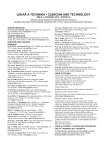-
Články
- Časopisy
- Kurzy
- Témy
- Kongresy
- Videa
- Podcasty
Multi-electrode microfluidic platform for protein detection using electrochemical impedance spectroscopy
An impedimetric sensor was developed based on parallel detection at two identical microfluidic channels with 3 pairs of interdigitated electrodes in each. Preparation and cleaning of the gold electrodes were examined and optimized. A self-assembling monolayer of 11-mercaptopropionic acid was deposited to form a base for later covalent binding of antibody proteins via EDC/NHS chemistry. Two immunoassays containing immune reaction of a 214D4 antibody and a corresponding MUC1ex antigen and a prostate antigen antibody immunoassay with positive and negative controls were performed in two parallel microfluidic channels. Presented platform enables a simultaneous analysis of the protein reactions on multiple electrodes leading to an improvement in on-time diagnostics and point-of-care.
Keywords:
Impedance sensor, protein adhesion, antigen – antibody interaction
Autoři: Jaroslav Lazar 1; Magdalena Bialon 2; Christiane Püttmann 2; Christoph Stein 2; Wilfred Germeraad 3; Uwe Schnakenberg 1
Působiště autorů: Institute of Materials in Electrical Engineering 1, RWTH Aachen University, Sommerfeldstr. 4, Aachen, Germany 1; Helmholtz Institute for Biomedical Engineering, Institute of Applied Medical Engineering, Dept. of Experimental Medicine and Immunotherapy, RWTH Aachen University, Pauwelsstr. 20, 52074 Aachen, Germany 2; Department of Immunology, Maastricht University Medical Center, Medical Center, Universiteitssingel 50, 6229 Maastricht, the Netherlands 3
Vyšlo v časopise: Lékař a technika - Clinician and Technology No. 4, 2015, 45, 105-109
Kategorie: Původní práce
Souhrn
An impedimetric sensor was developed based on parallel detection at two identical microfluidic channels with 3 pairs of interdigitated electrodes in each. Preparation and cleaning of the gold electrodes were examined and optimized. A self-assembling monolayer of 11-mercaptopropionic acid was deposited to form a base for later covalent binding of antibody proteins via EDC/NHS chemistry. Two immunoassays containing immune reaction of a 214D4 antibody and a corresponding MUC1ex antigen and a prostate antigen antibody immunoassay with positive and negative controls were performed in two parallel microfluidic channels. Presented platform enables a simultaneous analysis of the protein reactions on multiple electrodes leading to an improvement in on-time diagnostics and point-of-care.
Keywords:
Impedance sensor, protein adhesion, antigen – antibody interaction
Zdroje
[1] DANIELS, J. S., POURMAND, N. Labell-Free Impedance Biosensors: Opportunities and Challenges. Electroanalysis, 2007, vol. 19, p. 1239–1257.
[2] SCARANO, S., MASCINI, M., TURNER, A. P. F., MINUNNI, M., Surface plasmon resonance imaging for affinity-based biosensors, Biosensors and Bioelectronics, 2010, vol. 25/5, p. 957–966.
[3] VIDAL, J. C., DUATO, P., BONEL, L., CASTILLO, J. R., Use of polyclonal antibodies to ochratoxin A with a quartz–crystal microbalance for developing real-time mycotoxin piezoelectric immunosensors, Analytical and Bioanalytical Chemistry, 2009, vol. 394/2, p. 572–582.
[4] SANGDAE, L., KI-BOK, K., YONG-IL, K., Love wave SAW biosensors for detection of antigen-antibody binding and comparison with SPR biosensor, Food Science and Biotechnolog, 2011, vol. 20/5, p. 1413–1418.
[5] TANG, X. H., et al. Direct Protein Detection with a Nano-interdigitated Array Gate MOSFET. Biosens.Bioelectronics, 2009 24.12, p. 3531–37.
[6] BERDAT, D., RODRIGUEZ, A. C. M., HERRERA, F., GIJS, M. A. M., Label-free detection of DNA with interdigitated micro-electrodes in a fluidic cell. Lab Chip, 2008, vol. 8, p. 302–308.
[7] WANG, R., et al., Interdigitated array microelectrode based impedance immunosensor for detection of avian irus H5N1. Talanta, 2009, vol. 79, p 159–164.
[8] VAN GERWEN, P. et al. Nanoscaled interdigitated electrode arrays for biochemical sensors, Sens. Actuat. B, 1998, vol. 49, p.73–80.
[9] NARAKATHU, B. B., ATASHBAR, M. Z., BEJCEK B. E., Improved detection limits of toxic biochemical species based on impedance measurements in electrochemical biosensors. Biosens.Bioelectron. 2010, 26.2, p.923–928.
[10] PUETTMANN, C., KOLBERG, K., HAGEN, S., SCHMIES, S., FISCHER, R., NAEHRING, J., BARTH, S., A monoclonal antibody for the detection of SNAP/CLIP-tagged proteins. Immunology letters, 2012, PMID 23085606.
[11] VAN ELSSEN, C. H., FRINGS, P. W., BOT, F. J., VAN DE VIJVER, K. K., HULS, M. B., MEEK, B., HUPPERETS, P., GERMERAAD, W. T., BOS, G.M. Expression of aberrantly glycosylated Mucin-1 in ovarian cancer. Histopathology, 2010, 57/4, p. 597–606.
[12] ZOU, Z., et al. Functionalized nano interdigitated electrodes arrays on polymer with integrated microfluidics for direct bio-affinity sensing using impedimetric measurement. Sensors and Actuators A: Physical, 2007, Vol. 136, Nr. 2, p. 518–526.
[13] ZHANG, X., et al. A reusable electrochemical immunosensor for carcinoembryonic antigen via molecular recognition of glycoprotein antibody by phenylboronic acid self-assembly layer on gold. Analyst, 2008, Vol 133, Nr. 4, p. 485–492.
Štítky
Biomedicína
Článok vyšiel v časopiseLékař a technika

2015 Číslo 4-
Všetky články tohto čísla
- Multi-electrode microfluidic platform for protein detection using electrochemical impedance spectroscopy
- Effect of linear accelerator settings on evaluation of dosimetric verification of VMAT plans
- Spectral analysis of atrial components of ablation catheter signals during slow pathway ablation for typical atrioventricular nodal reentrant tachycardia
- MERANIE PARAMETROV ELEKTROMAGNETICKÝCH POLÍ PRI POUŽÍVANÍ PROSTRIEDKOV MOBILNEJ KOMUNIKÁCIE V ŠKOLSKOM PROSTREDÍ
- Lékař a technika
- Archív čísel
- Aktuálne číslo
- Informácie o časopise
Najčítanejšie v tomto čísle- MERANIE PARAMETROV ELEKTROMAGNETICKÝCH POLÍ PRI POUŽÍVANÍ PROSTRIEDKOV MOBILNEJ KOMUNIKÁCIE V ŠKOLSKOM PROSTREDÍ
- Spectral analysis of atrial components of ablation catheter signals during slow pathway ablation for typical atrioventricular nodal reentrant tachycardia
- Multi-electrode microfluidic platform for protein detection using electrochemical impedance spectroscopy
- Effect of linear accelerator settings on evaluation of dosimetric verification of VMAT plans
Prihlásenie#ADS_BOTTOM_SCRIPTS#Zabudnuté hesloZadajte e-mailovú adresu, s ktorou ste vytvárali účet. Budú Vám na ňu zasielané informácie k nastaveniu nového hesla.
- Časopisy


